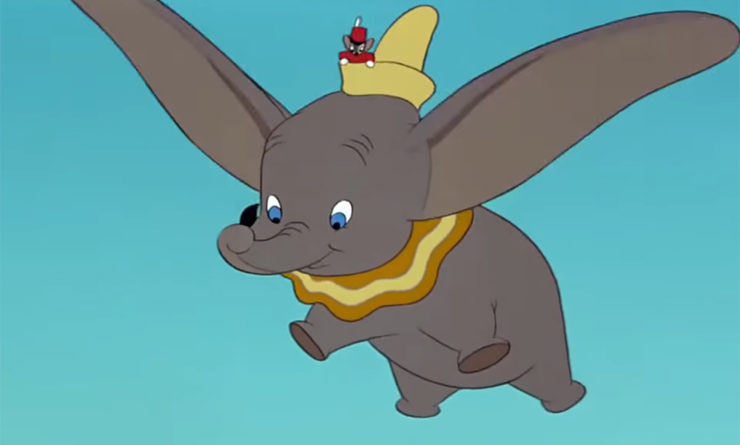In 1939-40—as work progressed on the fabulously beautiful, fabulously labor intensive and fabulously expensive Pinocchio, Fantasia, and Bambi—Roy Disney (always the practical member of the Disney family) told his brother Walt that above all, the next film had to be cheap. Very cheap. The profits from Snow White and the Seven Dwarfs and the cartoon shorts had been spent. The outbreak of World War II had closed European markets and cut off a significant part of the studio income from both features and cartoons. And although the United States had yet to enter World War II, Roy Disney correctly feared that war was inevitable. And those were just the external and financial issues. The studio also faced an increasingly hostile workforce of artists unhappy with their working conditions, Walt Disney’s ongoing interference with their work, and, above all, their pay.
Unfortunately, Walt didn’t have any very cheap projects on hand. Oh, he had plenty of ideas—elaborate adaptations of Peter Pan and Alice in Wonderland, and a version of Hans Christian Anderson’s The Snow Queen, which could use the same ice and color effects used so effectively—and expensively—in Fantasia. He even had early concept art for these and other projects. Roy Disney took a look, made some gloomy estimates and nixed these ideas.
Fortunately, some of Disney’s animators—and his head of merchandising—had found something a little less ambitious: a story about a little circus elephant with big ears that, in its original (and now impossible to find) form had run only a few pages. Simple, emotional, and above all short: it could be animated in bright colors with just a few backgrounds, with absolutely no shots of multiple moving cuckoo clocks, rocking caravans, hundreds of dancing brooms, leaves in the process of getting iced over, or forest fires—to name just a few of the recent moments that had brought Disney accountants to tears.
Their pitch put Walt’s other projects on hold. Walt refused to give up on Peter Pan or Alice in Wonderland entirely, but agreed to shelve them until animators could finish Bambi, still in agonizingly slow production. Concept art for The Snow Queen was largely shelved and forgotten about until the Disney Renaissance, when animator Glen Keane, at loose ends, took a look at it, drew a few pictures, and decided to work on adapting Rapunzel instead. In the meantime, animators started work on Dumbo.
Buy the Book
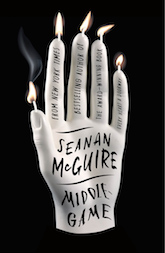

Middlegame
Nearly every aspect of this film was focused on the concept of saving money. Thus, the film used watercolor backgrounds, instead of oil and gouache, which took longer to paint and dry, a money saving alternative that Disney would return to decades later for Lilo & Stitch. With the exception of a few brief moments here and there—with the storks, a circus parade, a few of the elephant scenes, the trippy pink elephants sequence, and the crows—animators ensured that only two or three characters were on screen at any one given time, reducing the technical issues that had beset animators trying to animate 30 or more characters and objects at once. Even when the script required multiple characters, animators employed additional tricks: ensuring that only the heads of the elephants could be seen in one scene, for instance, or animating only the shadows of the characters—a trick that not only worked visually, since it allowed most of the human planning and plotting to happen in shadows, but also meant that animators did not have to draw nearly as many lines. The famous pink elephant sequence—an animation highlight—was planned less as a surreal, innovative, and occasionally terrifying animation sequence, and more as a cost saving device: it only needed simple, single color backgrounds. Money saved.
That simplicity also allowed animators to work quickly, producing about 120 to 140 animation drawings per day—in direct contrast to the eight to ten drawings per day that their colleagues in the same building were managing with Bambi. Animators also saved time by copying work directly from Fantasia and other cartoons for certain scenes, and ruthlessly cutting plot and dialogue whenever possible.
That didn’t stop delays, especially when on May 29, 1941—while Dumbo and Bambi were still in production, and a little less than a year and a half after Disney had moved its animation department to new, larger, shinier and more isolated quarters that animators claimed made collaboration more difficult—Disney workers went on strike. Many of the animators remained, with a few taking advantage of the animation slowdown to join the South America goodwill trip with Walt Disney that later resulted in the anthology films Saludos Amigos and The Three Caballeros. Enough artists picketed, however, to delay the already delayed Bambi still further, and also force the remaining animators to rush the rest of their work on Dumbo in a desperate attempt to get the film out in time for a fall release from RKO Studios.
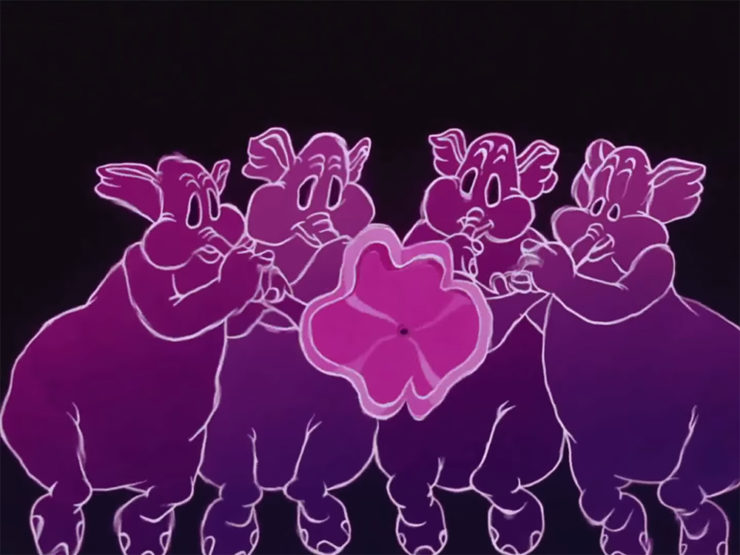
Legend claims that the brief scene in Dumbo of the clowns heading off to demand more money from the big boss—one of the very few clips in the film with no direct relationship to the plot—includes caricatures of the striking artists. Whether or not that is true (Disney sources deny it), other aspects of the strike are visible on the screen, including the way that the balancing elephant act sometimes has seven, sometimes has eight elephants, an error that perfectionist Walt Disney, under normal circumstances, would have noted two seconds before demanding that the entire sequence be scrapped and redone with the correct number of elephants. The baby tigers with difficult to animate stripes that make an early appearance virtually vanished from the rest of the film, replaced by easy to copy from Fantasia ostriches, even if tigers are slightly more typical circus animals.
The animators did throw in a few effects here and there—for example, the multiple shifting images shown for about one second when Dumbo first opens his eyes, some rather inexplicable snow in early shots (the rest of the movie takes place in Florida and the American South), and a scene of animated shadows. And bubbles—an effect that Disney artists had now mastered after three straight feature films with bubbles. But for the most part, Dumbo was created without the water and light effects that had been such a predominant part of Pinocchio and Fantasia. Absolutely no underwater sequences this time around, everyone agreed, and to further save money, poor little Dumbo had to jump into plaster instead of water since plaster required fewer special effects work than splashing water.
As a further cost saving, for most of the voice roles, Disney hired complete or nearly complete unknowns, some so unknown that they can’t be identified with any confidence, given that Disney didn’t credit any of the vocalists in the film. Dumbo does, however, mark the Disney debuts of then-radio, later television actress Verna Felton and film actor Sterling Holloway. Felton would later voice multiple roles for the studio, including, most notably, the Fairy Godmother in Cinderella, the Queen of Hearts in Alice in Wonderland, and Flora in Sleeping Beauty. Holloway would later voice the Cheshire Cat in Alice in Wonderland, Kaa in The Jungle Book and, perhaps most famously, Winnie the Pooh.
And to make up for all of these cheapness, Disney artists drew as much pathos into the film as they could possibly get away with.
As the movie begins, the storks, babies firmly clutched in their beaks, are flying to a pre-Disney Florida, where the Ringling Brothers Barnum and Bailey Circus spent the winter. You can tell it’s pre-Disney, not just because the simplified map doesn’t show Disney World, but because the animators had, based on their depiction of “Florida” never been anywhere near the state. (I’m in the “hilly” part of central Florida, and trust me, we’re not as hilly as those palm tree dotted backgrounds would imply.)
The pathos starts off almost immediately as poor Mrs. Jumbo, who is about to have one terrible animated hour, watches several other babies get dropped off to other mothers while sad music plays, but not to her. Things are about to get much worse. Her baby is finally delivered—late—by a tardy stork, who won’t let poor Mrs. Jumbo see her little baby until he finishes singing happy birthday and she signs a paper, and although her fellow elephants are at first thrilled to see the adorable little baby elephant, that thrill turns to horror when they see his oversized ears. If you ask me, the little elephant has plenty of time to grow into those ears, and in any case, he’s still adorable, but the other elephants didn’t ask me. Completely failing to appreciate that the baby elephant can use his ears as a baby blanket (this is very cute, grown up elephants!) they poke fun of him and name him Dumbo.
SNIFFLE.
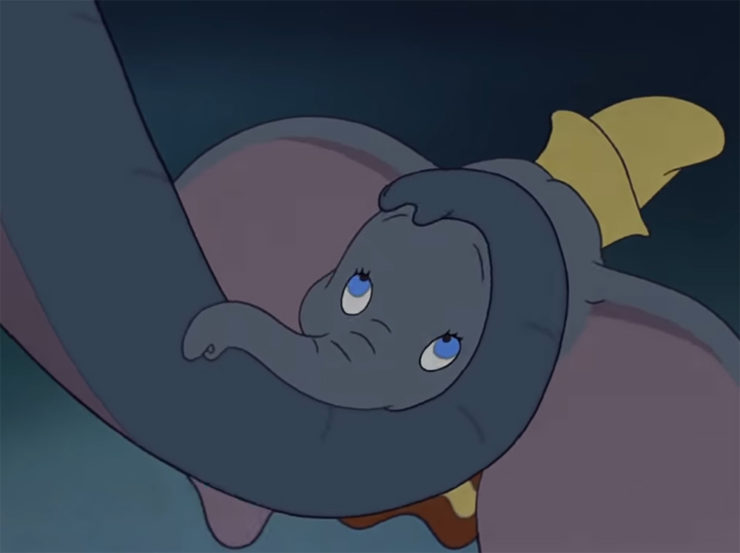
They aren’t the only ones to poke fun at the little elephant. A very mean boy also harasses little Dumbo, deeply upsetting his mother. After she strikes out at the kid, Mrs. Jumbo gets taken away (MORE SNIFFLING) to solitary confinement. Even the mean elephants are kinda horrified by this, but rather than feeling sorry for the poor little elephant, the older elephants shun him. It’s somewhat comforting to note that the three meanest elephants later end up at the bottom of an elephant pyramid, but only somewhat.
All of this arouses the pity of Timothy Q Mouse, who decides to try to make the little elephant a star. “Star,” in circus terms, is not always a good thing: poor little Dumbo gets turned into a clown (sniffle) and then forced to perform in a burning house. It’s at this point that many small children start collapsing in tears. Not surprisingly, Dumbo and Timothy get completely drunk after this—it’s portrayed as accidental, but wow, if I were little Dumbo at this point, I’d want a drink too. It’s surprisingly powerful liquor: after just a few sips, both of them start hallucinating, and then find themselves up in a tree.
That’s right: Dumbo may have the saddest life of a little animated elephant ever, but at least he can fly.
In between all this are various small moments trying to fill out what is a rather thin story—shots of the circus train trying to climb up a mountain, elephants and circus workers trying to put up the big tent in the rain, clowns planning new acts, a (very) brief circus parade, and clowns drinking heavily. My limited knowledge of the circus—garnered almost entirely from Cecil de Mille’s gloriously terrible film The Greatest Show on Earth, suggests that most of this is more or less accurate, if simplified, except for the animals that wandered in from Fantasia tracings.
Also in between all this, what for most people is probably the animation highlight: the surreal and deeply weird dream sequence, pink elephants on parade. I say “most people” because this is the other moment when several small children abandon the film in sheer terror or collapse in tears. Grown-ups, however, can take delight in the sheer exuberance of this sequence, as bubbles turn into pink elephants which turn into marching instruments before turning into … well, a lot of things. I kinda question the belly dancing elephants moving through dancing pyramids, but the moment right after that—where dream elephants outlined in brilliant pink and green dance with each other before one of them turns into a staircase that the other one climbs—well, Disney never captured the shifting nature of dreams as well again, then or later.
Less of a highlight: the sequence with the crows. The crows sound like stereotypes of black Americans, and it says something—and not a good something—that in a film that contains several images of black circus workers, the crows are the only black characters who get to speak. And at least two of them were voiced by white men, including the lead crow, Jim Crow (yes, that’s his name), voiced by ukulele player Cliff Edwards, better known for voicing Jiminy Cricket and singing “When You Wish Upon a Star.” Since Disney did not credit any of the voice actors, it’s even possible that all five were voiced by white men, in a distressing example of animated blackface.
Against this, Disney did hire the innovative black vocalist group the Hall Johnson Choir, to sing “When I See an Elephant Fly.” And, for the first time in Disney feature film history, blacks and other people of color actually appeared on the screen, as musicians, camel riders, and general circus workers. A blink and you really will miss it moment shows black and white men working together to put up the circus tent. Later, both blacks and whites join together to shackle Mrs. Jumbo and prevent her from stomping on a young boy, and another blink and you’ll miss it moment shows a black and white man laughing together.
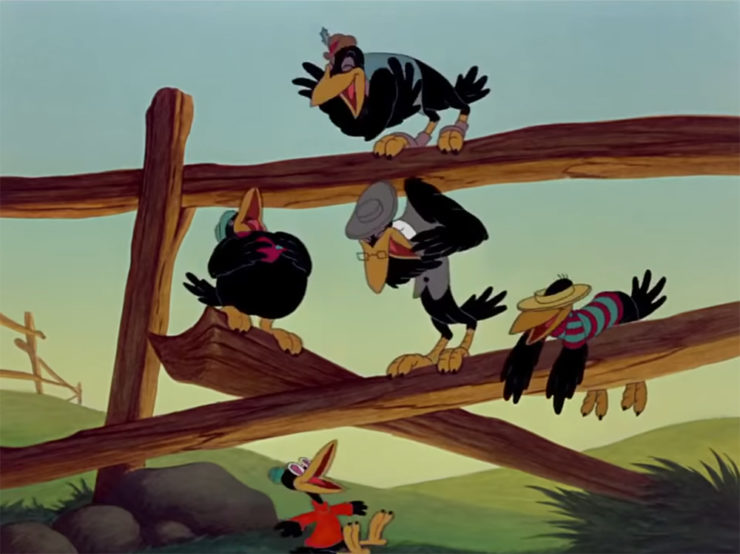
Racial integration and equality this certainly isn’t—true to the period, the circus audience is white; the clowns are all white; and the circus parade has pretty clearly divided up its workers by race—but at least they are there, in what until the 1990s, and even later, would be a rare exception for Disney.
More importantly, I think, the only really mean characters in the film are either white (the boys who tease Dumbo, the clowns that force poor little Dumbo to jump into plaster, the Ringmaster who goes along with this, and the men that drag Mrs. Jumbo off to her prison) or elephants. The circus worker who pulls Dumbo out of the fray, preventing him from further injury, is black. And, of course, the entire film is about the need for toleration and kindness, and the insistence that yes, the marginalized, the mocked, and the seemingly different can succeed, even after society has excluded them. Still, the crow sequence has not, to put it mildly, aged well.
It all ends on a seemingly joyful note, as Dumbo’s ability to fly turns him into a hero and a star—though the joy is mixed with fear. As the final moments clarify, it is 1941: headlines contain references to military offensives and attacks, and another moment has “Dumbombers for Defense!” It’s a dark note, in an often sad movie, undercutting the happy ending.
As a kid, I hated this film, mostly because I hated, but hated, all of the grown-ups in it except for Mrs. Jumbo. The elephants were mean; the clowns were mean; the circus master was mean; the crows—when they first appeared—were mean. The glimpses of kinder adults were few and far between—and Timothy is so small that until the very last moments of the film, when he’s seen signing a contract for Dumbo, that he doesn’t always come across as a grown-up. And the little kids weren’t much better. THEY WERE MEAN TO DUMBO and they made fun of his ears. I wanted Mrs. Jumbo to stomp on them, and those mean adults wouldn’t let her. Any lingering tolerance I might have had was shattered when, as a teenager, I tried to watch the film with a three year old who completely lost it during the pink elephant sequence and spent the rest of that evening cowering in terror, convinced that elephants were going to eat him.
I’ve mellowed a bit since. It helps that I can now recognize that even the Elephant Matriarch has her good points—she works diligently to put up the circus tent, for instance, despite the rain, and she does her absolute best, to the point of risking her own safety and picking up some very real injuries, to prevent the disaster that strikes the entire circus tent after Dumbo trips over his ears. The clowns—whether or not they represent Disney animators—now come across as underpaid workers struggling to earn a decent living, even if I can’t quite get aboard with their methods. He’s a little baby elephant, clowns! Can’t you see how cute he is? HOW CAN YOU BE SO MEAN TO HIM?
But mostly, although I still can’t find this a kindly portrayal, I can now find it an accurate one. As Dumbo acknowledges, the world is not always kind to small children, especially small children wrenched away from their mothers. But Dumbo also gives hope: in this film, the small children triumph. And sad as the image is of little Dumbo having to walk away and leave his mother in a cage (SNIFFLE), Dumbo also shows us a mother and baby reuniting after a painful separation through physical force—a separation that tragically mirrored real life events in the 1940s. That reunion and the hope might have been a little less realistic, but it was a hope badly needed the year the film was released.
Though getting the film released took a bit of negotiation. At 64 minutes, Dumbo was too long to be distributed as a cartoon short, and in the opinion of distributor RKO Radio Pictures, too short to be distributed as a full length film. It’s even shorter when you realize that 1:16 of the 1:03:52 running time are dedicated to the opening credits. RKO wanted at least ten more minutes added to the film, or, failing that, 45 minutes cut from the film, to allow it to be released as a cartoon short. Disney, exhausted from the recent strike, and estimating that adding ten minutes to the film would cost them at least $500,000, flat out refused. A reluctant RKO backed down and showed the film—and finally, finally Disney had a hit again.
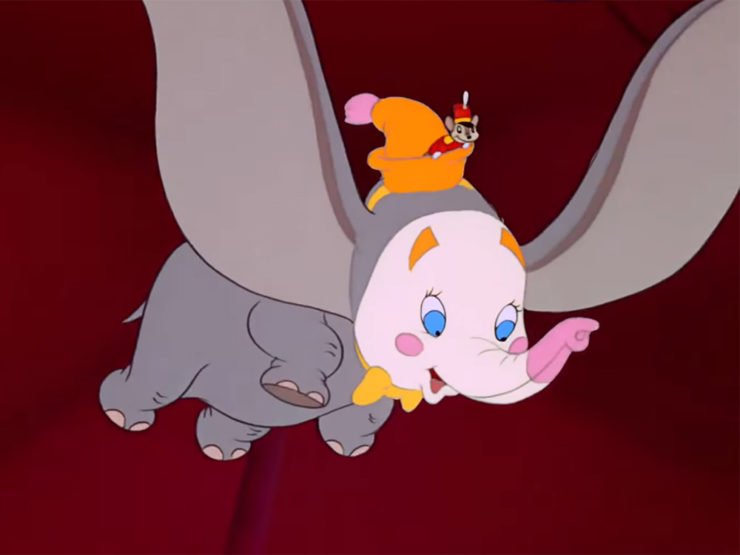
The box office take—$1.6 million—may seem like nothing now, but at the time it was a much needed success for the studio, injecting cash into their coffers just months before the U.S. entry into World War II, and as animators were still working to finish up the much more elaborate Bambi. Long term, Dumbo also turned out to be a financial boom for Disney. All six current Disney theme parks, including the recently opened Shanghai Disneyland, have a Dumbo the Flying Elephant ride, and sell Dumbo merchandise, including plush toys, key chains, trading pins, and T-shirts. Dumbo himself made a cameo appearance in Who Framed Roger Rabbit, and if you pay very close attention to A Bug’s Life, you might catch a glimpse of Casey Jr. Cookies. For the least ambitious, least costly of the Disney pre-war films, it was quite a legacy.
Originally published in July 2016 as part of our Disney Rewatch series.
Mari Ness lives in central Florida.










